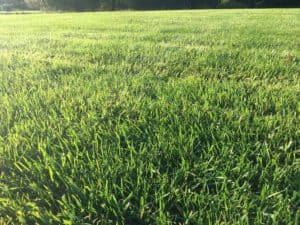Lime Application
Why is Lime Good for a Lawn?
The quick answer:
Soil in our area becomes more and more acidic over time. Why does this matter??… When your lawns soil is acidic, the grass cannot use all of the nutrients (think ‘Lawn Food’) that are available in the soil. Lime reduces the acidity in the soil which creates a healthier, more natural soil environment for your grass.
Lawn lime applications make soil pH less acidic. Soil pH affects turfgrass by making plant nutrients and other elements more available to the plant. The further away from the ideal pH the soil gets, the less the plant can utilize the nutrients in the soil. Lime also speeds thatch decomposition, limits some turf-damaging insects and diseases, and improves the ‘living environment’ of the soil. These are several very good things for a lawn – all in one product.
The not so quick answer:
Turfgrass prefers a soil pH in the 6.5 – 7.0 range. The pH value describes the degree of acidity or alkalinity of the soil. In our part of the country, the soil tends to get more and more acid over time. This is caused by multiple factors including natural organic activity and decomposition in the soil as well as acid rain.
The closer the soil pH is to the 6.5-7.0 range, the more the plant can use the available nutrients (and vice versa). Therefore, if your soil is acidic, and you want to get the most benefit out of the fertilizer and other nutrients available to the grass, liming would be helpful and recommended.

How Fast Does It Work?
It can take several years to significantly raise the Ph in the soil but, in our experience, within a year there is most often some improvement. On average, in southeastern Pennsylvania, applying 30 lbs. of lime per 1,000 square feet is considered a “maintenance level”. This means the lime should keep the soil from becoming more acidic but will not move the pH to a more basic level – you’re treading water. A rate of 50 lbs./1,000 square feet is typically a good rate to apply if you need to make some headway. This is why annual liming is recommended for most lawns in our part of the world.
What Kind of Lime Should I Use?
You probably have seen farmers spreading white lime in their fields (and the white cloud of powder following the tractor). This is the best form of lime to use since is the most finely crushed limestone available.
However, you probably don’t want a mess of white powder all over your lawn. Therefore, use pelletized lime. These lime pellets for lawns are the white powdered lime that farmers use, compressed into small pellets. In the end, you get the same product farmers are using, just in a cleaner form. Also, when the lime is pressed into pellets, the color changes to brown and it is hard to see – much better than looking like your lawn is covered in snow! Read more about it in our blog – Lime Application – why isn’t my lawn white?
One advantage farmers have is that they can plow the lime into the soil. Since our customers get upset when we plow up their lawns, the lime doesn’t get down into the soil profile as fast. However, there is a solution to this. Aerating the lawn at the time of liming allows some of the lime to get down into the root zone.